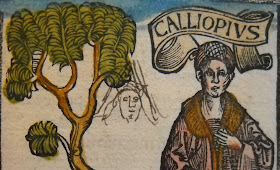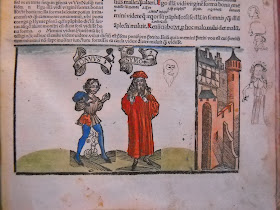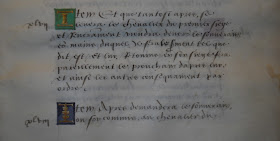
We continue to build our collection of vernacular secular manuscripts with our latest acquisition,
The Statutes of the Order of the Golden Fleece. It was most likely produced in 1531 at the request of Charles V to be distributed to all of the knights of the Order. This copy is utilitarian in that it was meant to be used, but also had enough decorative flourish to make it a treasured object.
At first, it seems the manuscript is an anachronism: 80 years after the invention of moveable type, it is still entirely done by hand. But printing in the early hand-press era demanded scale to make it profitable. If you only needed 50 copies (and the Order of the Golden Fleece was limited to 50 members) then it would have been cheaper to produce manuscript copies than set the type and print them. Generally speaking, printing only pays for itself after about 200 copies, but then it can become quite profitable. Still, members of the Order would have expected something more dignified than print, and this manuscript fits the bill.
The description of the manuscript from
Les Enluminures included this account of the Order and the manuscript in hand:
The most renowned of all chivalric orders, the Order
of the Golden Fleece was founded in 1430 by Phillip the Good, duke of
Burgundy (1396-1467) "out of respect for God and for the advancement of
the Christian Faith." It was instituted as a Burgundian alternative to
the influential Order of the Garter, founded in 1348 by Edward III, and
designed to strengthen the allegiance of Phillip's vassals and friendly
foreign states to his realm.
The Order of the
Golden Fleece, whose first chapter was held in 1431, came to be
considered the highest order of knighthood. It originally included
twenty-four knights; the 1431 statutes fixed the number admitted to 31
(later increased to 51 by Charles V in 1516, and then to sixty-two by
Philip IV) and four officers (Chancellor, Treasurer, King of Arms, and
Greffier). Upon being inducted as a member, each knight received, in
addition to the famous collar from which a gold enameled pendant of the
Golden Fleece was suspended, a copy of the Statutes—also referred to as a "quayer de l’ordre"—most often in manuscript form and copied on vellum.
The official language of the Order, and therefore of the manuscripts,
was the langue bourguignonne, but from the sixteenth century
some manuscripts were copied in Latin. Following the death of a knight,
the copy of the Statutes and the collar were supposed to be returned to
the Archives of the Order, but this rule was not rigorously respected
and numerous copies of the Statutes remained in circulation.
This
manuscript is a copy of the Statutes enacted in 1531 after the chapter
held in Tournai; it includes the thirteen additions made to the statutes
up to that year. The manuscript was certainly copied before 1545, the
year of the chapter held in Utrecht where a new draft of the Statutes
was instituted with 68 articles rather than the traditional 66. During
the chapter of 1531, complaints were voiced concerning the numerous
copies of the Statutes in circulation whose content was both erroneous
and incomplete. Hence the greffier Laurent de Blioul was ordered by Charles V (1500-1558)
to have 50 new exemplars copied, some in French, others in Latin,
complete with thirteen added articles, to be distributed to all the
knights (Reiffenberg, 1830, p. 382-7, and de Lannoy, 2000, p. 38).
Payment for sixteen copies was recorded in October, 1532 (Korteweg in
Cockshaw and Van den Bergen-Pantens, 1966, p. 43, note 48). The present
manuscript is probably one of these "revised" copies (Korteweg, in
Cockshaw and Van den Bergen-Pantens, 1966, p. 43, note 50 lists nine
additional copies in public collections). Presumably most of the
existing knights already owned luxury illuminated copies of the text,
which they would not want to discard, so they would have needed
relatively plain, practical volumes (such as the present one), with an
accurate text, rather than a new lavishly illuminated copy.
You can see it by asking for
Codex MS 003234.
 We recently digitized one of our nicest humanist manuscripts: a copy of Terence's Comoediae sex cum argumentis produced in Ferrara in 1462, just a few years prior to the introduction of the printing press in Italy. You can see it in its digital glory, or come in and feel the vellum for the full sensory experience.
We recently digitized one of our nicest humanist manuscripts: a copy of Terence's Comoediae sex cum argumentis produced in Ferrara in 1462, just a few years prior to the introduction of the printing press in Italy. You can see it in its digital glory, or come in and feel the vellum for the full sensory experience.


